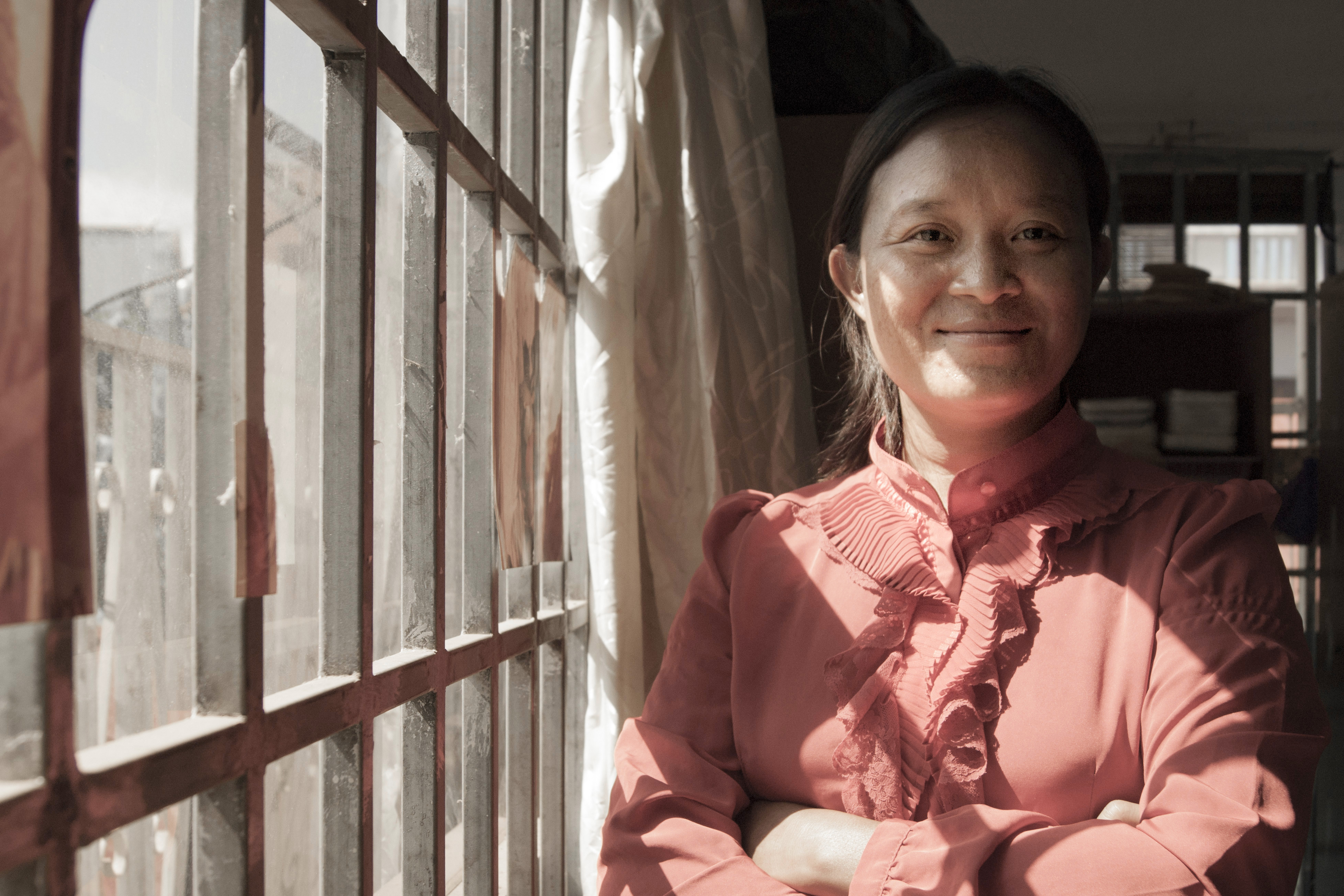Over the past 12 years Anjali House has seen many people come and go from Cambodia and across the world, each contributing to the best of their abilities.
In 2005, Anjali House began with a one-off dance troupe, lead by Sangeeta Isvaran, and a photography workshop initiated by Magnum photographer Antoine d’Agata. From then to now, Anjali House has become an institution and a sanctuary to 120 students by providing education, basic care, healthcare and family support.
Our Khmer Director, Simon Ke, has witnessed and guided Anjali House through out these years. Her quiet determination and gentleness is the nurturing force behind the change Anjali House has been able to bring about. This month the focus is on tracing the development of Anjali House through her ever smiling eyes.

Simon Ke, Director, Anjali House
How did you get involved with Anjali House?
I used to be a Khmer teacher in Siem Reap. In 2006, Angkor Photography Association tied up with Life and Hope Association, an organisation set up by the monks of Wat Damnak temple, to provide equal access to education for the underprivileged and I decided to join because I believe in the change education can bring for the people of my country. I’ve been here ever since. I was the Assistant Manager for first 8 years and in 2014 I became the director. It’s such a positive environment that I don’t think I will ever want to leave.
Did you face any particular challenge since becoming the director in 2014?
I wouldn’t say I faced any problems in particular. I believe that all NGOs go through the same life cycle and I am glad that the NGO community is extremely supportive of each other and ever ready to help. We have all learnt from each other and grown together. 2008 was an extremely tough time for the whole community financially and we were eventually able to ride the tide because everyone contributed.
Are there anythings you would have done differently? Or is there anything that you wish you should have done but didn’t?
I think we all learn from experience and mistakes. Taking Anjali House to where it is now is not about one step but a series of steps. I try to learn from the past and try to better the next step I take. The last few years have been a huge learning curve and hopefully I will be able to implement the changes I want to see.
I’ve attended a lot of workshop organized by other NGOs and all of them have helped me to and improve things here at Anjali.
Being a small local NGO, how challenging was it to attract the first few donations?
It can be very challenging at the beginning especially raising funds to run and support the programs. But as I mentioned before, we’re lucky to have a large and supportive network of NGOs that have helped us in the past. Anjali House is a project incubated by the Angkor Photo Association, so they supported us for the first few years which helped run classes for the first 20 children.
Gradually the donations came in slowly, from locals, organizations and volunteers. We have made considerable progress considering we can now afford to support 120 children. Our programs have also become more holistic and have gone beyond just education. In 2007, Anjali House began classes with 20 students, 2 teachers, 1 cook, 1 driver and 1 social worker with classes in Khmer, English and Photography. Today we have a full fledged Basic Care, Young Adult and Family Support Program to ensure the overall development of our children. To be able to incubate and run these programs requires more funds but over the years we have become more financially stable.
How did you develop these programs?
The two programs, aside from education, that we are really proud of are the family support and the young adult program. The idea came from Richard, one of our older volunteers, who thought that Anjali needed to start offering more to their older students in order to fully complete their learning process and train them for their life after Anjali House. We all thought it was a brilliant idea, as basic education can give you a strong foundation but that is not enough to be a successful person. Considering a lot of our students come from underprivileged and dysfunctional households, they also need support to overcome some of these challenging times and become emotionally sound to face the future. Starting up the programs did obviously need financial support, and that’s when Remko Vochteloo, our now Chairman,stepped in and donated funds to develop these programs.
How does the family support program work at Anjali House and how has it evolved over the years?
The Family Support program always existed, but it has transitioned over a period of time to have a greater impact on the families we support. At first Anjali only provided aid in the form of rice. We soon realized the work we were doing with the children needed to be supplemented by educational programs for their parents. What began with financial support has now transitioned into social support. We generally offer workshops about life and parenting skills including financial planning. Since Mom, our social worker, started working at Anjali House, she began offering psychological support for both families and children so that they could have someone to talk to about any problem or concern they might have.
And the Young Adult program seems to be making a lot of news too. Can you tell us more about the program?
The majority of Anjali House students remain with us until reaching the age of 16. The Young Adult program is about providing support to our children in making decisions about their future lives and career options. The students learn English, computer skills, life and leadership skills and participate in career orientation classes. We try our best to resolve issues pertaining to growing up in dysfunctional families through one-on-one counseling sessions and workshops.
Some of the topics that we have covered during our workshops include topics such as problem solving, decision making, how to be a better public speaker, bullying, positive thinking, domestic violence, reproductive health and basic hygiene.
You mention how the volunteer network has helped How did you grow the network of volunteers at Anjali House?
The Network of NGOs in Siem Reap has helped us considerably with volunteers, something I’m really glad of because volunteers are an essential part of our team and the work we do. Just as it happened with the first few donations, other local organizations helped us reach out to volunteers initially. Now we receive direct inquiries from people trying to donate their time and this has helped us reach out to a much larger community. In 2017, we welcomed more than 50 volunteers from around the world. In our organisation all supporters and volunteers are essential in helping achieve our mission, which is to help our students develop into healthy, well-adjusted young adults, equipped with the skills they need to be successful in their future endeavours.
What are your plans for the future?
We would like to improve the benchmarks we have set ourselves and we are happy that in many respects we are doing better than the national average. For example none of our students under the age of 16 are working compared with 36% of Cambodian children aged 5-14 who are working. In 2017, 11 students dropped out of Anjali House of the 120 students enrolled in grades 1-12. In 2016, we registered a 9% annual drop out rate compared with approximately a 19.4% annual drop out rate nationally for grades 1-12. So yes, while we celebrate these successes we are only looking ahead to better these milestones.
I also want to grow in terms of funds so we can continue to diversify our education programs and create more opportunities to impact the larger community in Cambodia. There is still so much work that needs to be done and so many more children that we want to help and so in time we will expand our connections outside Siem Reap.
Donate now and be a part of the change :
- Chuffed: https://bit.ly/3ucnBFq
- Khmer care: https://bit.ly/3T7F4cz
Read more articles:
